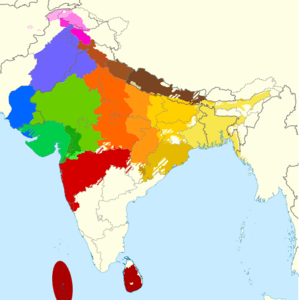Northern Indo-Aryan languages facts for kids
Quick facts for kids Northern Indo-Aryan |
|
|---|---|
| Pahari | |
| Geographic distribution: |
Nepal and north-western India |
| Linguistic classification: | Indo-European
|
| Subdivisions: |
—
|
The Northern Indo-Aryan languages, also known as Pahāṛi languages, are a group of Indo-Aryan languages. People speak these languages in the lower parts of the Himalayas. This region stretches from Nepal in the east to parts of India. These Indian states include Jammu and Kashmir, Uttarakhand, Himachal Pradesh, and Punjab.
The word 'Pahar' means 'mountain' in many local languages. This includes Nepali and Hindi. Because these languages are spoken in the Himalayan region, they are also called Himalayan languages. Like other languages in this area, Pahari languages belong to the Indo-European family. More specifically, they are part of the Indo-Iranian branch. The name "Pahari languages" was first used by a scholar named G. A. Grierson.
Contents
Main Groups of Pahari Languages
The Pahari languages are divided into three main groups. These groups are Eastern, Central, and Western.
Eastern Pahari Languages
- Nepali is spoken by about 11.1 million people in Nepal. It is also spoken by 265,000 people in Bhutan and 2.5 million in India. Nepali is an official language in both Nepal and India.
- Jumli is spoken by around 40,000 people. They live in the Karnali zone of Nepal.
- Doteli is spoken by about 1 million people. These speakers live in the far west of Nepal. Some people think Doteli is a dialect of Nepali. Others, like the Nepalese Language Commission, consider it a separate language.
Central Pahari Languages
- Kumaoni is spoken by about 2.36 million people. They live in the Kumaon region of Uttarakhand, India.
- Garhwali is spoken by about 2.9 million people. Most of these speakers are Garhwali people from the Garhwal region of Uttarakhand.
Western Pahari Languages
The Western Pahari group has many different languages.
- Jaunsari
- Nuclear Himachali includes:
- Hinduri
- Pahari Kinnauri
- Kullu Pahari
- Mahasu Pahari
- Sirmauri
- Mandeali
- Kangric-Chamealic-Bhattiyali group includes:
- Chamealic languages:
- Bhadarwahi
- Churahi
- Bhattiyali
- Bilaspuri
- Chambeali
- Gaddi
- Pangwali
- Kangri-Dogri languages:
- Dogri
- Kangri
- Chamealic languages:
How Pahari Languages Are Similar
Even though mountains can separate communities, these dialects often share some features. This creates what is called a dialect continuum. This means that languages spoken close to each other are often very similar. The further apart they are, the more differences you might find.
See also
 In Spanish: Lenguas pahari para niños
In Spanish: Lenguas pahari para niños
Images for kids



